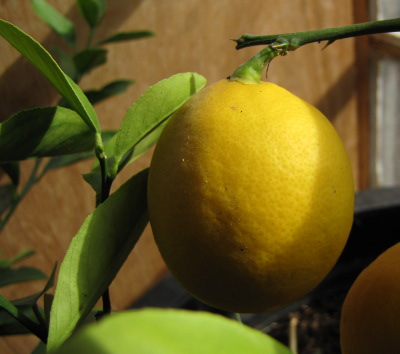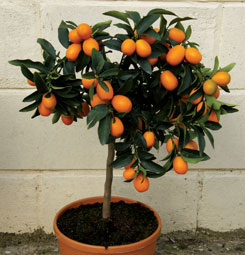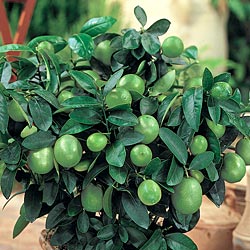
Best indoor dwarf citrus varieties
 By
far, the most common dwarf citrus variety is the dwarf
Meyer lemon.
This variety was grown in containers in China before being
"discovered" by Frank Nicholas Meyer and brought to the United States,
and it is probably the best-suited variety for indoors
cultivation. Meyer lemons can handle lower temperatures during
fruit ripening, which is a factor that makes some dwarf citrus drop
fruits during indoor winters. We and our friends have had great
luck with Meyer lemons and only spotty luck with other varieties, so if
you want a sure bet, go for a dwarf Meyer lemon.
By
far, the most common dwarf citrus variety is the dwarf
Meyer lemon.
This variety was grown in containers in China before being
"discovered" by Frank Nicholas Meyer and brought to the United States,
and it is probably the best-suited variety for indoors
cultivation. Meyer lemons can handle lower temperatures during
fruit ripening, which is a factor that makes some dwarf citrus drop
fruits during indoor winters. We and our friends have had great
luck with Meyer lemons and only spotty luck with other varieties, so if
you want a sure bet, go for a dwarf Meyer lemon.
Variegated
Pink lemon is
another citrus well-suited to indoor growth. Like Meyer  lemons,
Variegated Pink lemons handle indoor conditions well, but the tree is
slightly larger, making it hard to fit in your living room.
lemons,
Variegated Pink lemons handle indoor conditions well, but the tree is
slightly larger, making it hard to fit in your living room.
Trovita
and Calamondin
oranges
are the easiest oranges to raise indoors according to some
websites. The Calmondin isn't actually a true orange, but a cross
between a kumquat and a tangerine, so don't expect big fruits.
We've only tried Washington
Navel orange,
which has set its first fruits this year. I'll keep you posted
about whether the Washington Navel keeps those tiny fruits and turns
into our second successful dwarf citrus variety.
Limes are interesting
because you can grow them either for leaves or for fruits (or
both.) Kaffir lime is the variety most often
grown for leaves used to season food. We're  currently growing a Dwarf Key
lime
--- no fruits yet, and it's about the same age as the Washington Navel
orange, but it's going to get another year of grace before we give up
on it.
currently growing a Dwarf Key
lime
--- no fruits yet, and it's about the same age as the Washington Navel
orange, but it's going to get another year of grace before we give up
on it.
Grapefruit often need
high heat to ripen fruit, so it's a bit tricky to grow them
indoors. Oro Blanco
grapefruit is
reputed to be delicious and also tolerant of indoor conditions.
Which dwarf citrus
varieties have you tried and loved or hated?
| This post is part of our Dwarf Citrus lunchtime series.
Read all of the entries: |
Want more in-depth information? Browse through our books.
Or explore more posts by date or by subject.
About us: Anna Hess and Mark Hamilton spent over a decade living self-sufficiently in the mountains of Virginia before moving north to start over from scratch in the foothills of Ohio. They've experimented with permaculture, no-till gardening, trailersteading, home-based microbusinesses and much more, writing about their adventures in both blogs and books.
Want to be notified when new comments are posted on this page? Click on the RSS button after you add a comment to subscribe to the comment feed, or simply check the box beside "email replies to me" while writing your comment.

We have a Meyer Lemon, a Key Lime, a Meiwa Kumquat, Washington Navel Orange, and a Tangerine and Orange that we are uncertain of the variety (they came as a 3 n 1 Citrus deal but it was 3 plants in one pot so we separated them.)
We have had our Meyer Lemons grow to be almost full size then a squirrel ripped them off our tree and last year I over watered and the tree was down to just 6 leaves and 3 fruit so I took the fruit off so it could recover. Now it's growing great has lots of new growth 2 fruit so far, and a couple dozen blossoms. Very resilient.
We just got the Navel Orange and the Key Lime. The Key lime needed some severe pruning and is putting out new growth as well as flowers, it has one fruit on it from when we received it. The Orange hasn't shown much signs of new growth.
The Kumquat is loaded with fruit from when we got it but haven't had it long enough to give a detailed report.
One of our other two mystery Orange or Tangerine trees flowered and has a fruit on it hopefully I'll get to see which it is when it is finished maturing.
Not a citrus but we also recently acquired a Pineapple Guava.
I tried with a meyer lemon for about 3 or 4 years and gave up. What I got were some nice blooms and that was it. But I should note I have almost no sun. For winter I would send the tree to a friends house so it could sit in his sunny kitchen. The last year I just handed over to another friend and with him it died. I just need to buy a house with a sunnier exposure.
Brian --- great rundown on all of your citrus trials. Meyer lemon does seem to be the easiest, in our (more limited!) experience.
Marie --- Sun and food are essential. As I mentioned in a previous post, you can't expect much out of any kind of fruit plant if you don't give them quite a bit of TLC. That makes dwarf citrus a bad choice if you think of them as a houseplant. I consider mine to be part of the food garden, so I give them the best of everything and they reward me in exchange.
The Meyer lemon is, indeed, a Meyer after seeing photos of yours. I thought the fruits were too big to be Meyer lemons.
I forget what the lime is, probably a Mexican although the guy who gave it to me might have said it was some kind of Indian variety. The fruits are tiny, perhaps because I only fertilize it once a month. (The man who gave it to me recommended monthly fertilizing and the tree hasn't died, so ...) I'll bump the feeding up to once a week and see what happens.
Thanks for a great lunchtime series. I learned a lot and am looking forward to more citrus fruit from my trees.
Yup, Meyer lemons can be huge. They're really a hybrid with an orange, thus the size and sweetness.
Your lime might be a key lime --- I believe those fruits are naturally small. If your tree is ripening plenty of fruits, your fertilization regimen is probably working great for it.